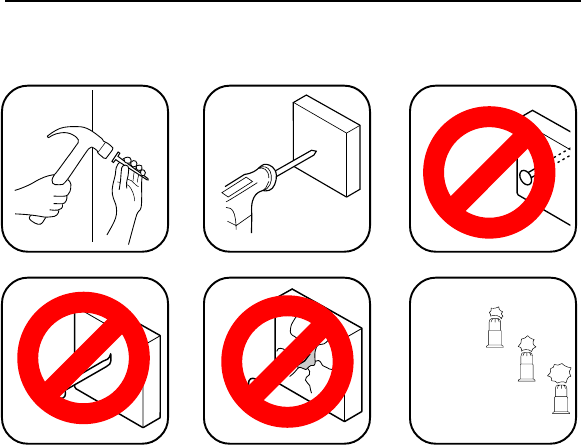
9
101719
Safety Precautions
Mesures de précautions
KNOW YOUR FASTENING BASE MATERIAL
BIEN CONNAÎTRE LE MATÉRIAU DE BASE
TOO BRITTLE
TROP FRAGILE
Surface
shatters
La surface
se brise
en éclats
TOO HARD
TROP DUR
Point
flattens
La pointe
s’aplatit
TOO SOFT
TROP TENDRE
Sinks in with
average hammer
blow
S’enfonce avec
un coup de
marteau moyen
CENTER
PUNCH TEST
TEST DE
POINÇONNAGE
CENTRAL
G 018
G 018
G 018
?
?
?
?
482-26
START
COMMENCER
4
YELLOW
JAUNE
3
GREEN
VERT
5
RED
ROUGE
1. Always know the thickness and type of base material into which you are
fastening. Never guess. Test the base material by using the Center Punch Test.
The Center Punch Test is performed by using a hammer to test drive the
particular power fastener to be used into the material. If the point penetrates
easily, the material is too soft. If the point becomes blunt, the material is too
hard. If the material fractures, cracks or shatters, the material is too brittle. Test
fastenings can be made if the material shows a clear fastener impression and
the fastener point is not blunted. Always start with the lowest power load
(Green-Level 3) and proceeding with the order shown in the lower right-hand
figure above. Always wear approved goggles.
Toujours connaître l’épaisseur et le type de matériau dans lequel les fixations
sont placées. Ne jamais deviner. Tester le matériau de base à l’aide du test de
perforation. Le test de perforation se fait à l’aide d’un marteau et du type de
fixation désirée pour le matériau. Si la pointe pénètre trop facilement, le
matériau est trop mou. Si la pointe s’émousse, le matériau est trop dur. Si le
matériau se fracture, craque, ou éclate, il est trop friable. Si la fixation s’enfonce
bien et si sa pointe n’est pas émoussée, on peut alors faire des tests de fixation.
Toujours commencer avec la charge la moins forte (vert-niveau 3) avant de
continuer suivant l’ordre indiqué dans la figure ci-dessus, en bas à droite.
Toujours porter des lunettes de protection homoloquées.


















